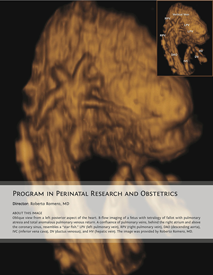You are here: Home > Program in Perinatal Research and Obstetrics
Program in Perinatal Research and Obstetrics
Director: Roberto Romero, MD
The Program in Perinatal Research and Obstetrics (PPRO) conducts clinical and laboratory research on maternal and fetal diseases responsible for excessive infant mortality in the United States. The Program focuses on the mechanisms of disease responsible for premature labor and delivery, with particular emphasis on the role of subclinical intrauterine infection and inflammation. The prenatal diagnosis of congenital anomalies is also a major area of interest.
The Perinatology Research Branch was created by Public Law (1993) to address the causes of excessive infant mortality in the United States. The Branch, now called the Program in Perinatal Research in Obstetrics, uses a multidisciplinary approach to study complications of pregnancy, which include the disciplines of Maternal-Fetal Medicine, Neonatology, Placental Pathology, Perinatal Epidemiology, and High-Dimensional Biology (genomics, proteomics, metabolomics, and computational biology), as well as Immunology, Microbiology, and Nanomedicine. The Program is currently housed in Detroit, Michigan, on the campus of Wayne State University and at the Detroit Medical Center. The location is appropriate because of the high perinatal and infant mortality in the city, as well as the contribution of ethnic social disparities to adverse pregnancy outcome. The PPRO provides state-of-the-art prenatal care to women enrolled in NICHD protocols and has made major contributions to the diagnosis of congenital anomalies and the understanding of the mechanisms of disease in premature labor/delivery and preeclampsia.
Preterm birth is the leading cause of perinatal mortality and morbidity worldwide and affects 12% of all pregnancies in the United States. The Perinatology Research Branch proposed that preterm parturition is a syndrome caused by multiple pathologic processes, one of which is an untimely decline in progesterone action, which is manifested by silent shortening of the uterine cervix. Several lines of evidence suggest that administration of vaginal progesterone to patients with a short cervix may reduce the rate of preterm birth. Indeed, previous work conducted by the Program showed that asymptomatic women who have a cervical length of less than 15mm in the second trimester of pregnancy have a 50% likelihood of delivering an early preterm neonate. However, prediction of preterm birth should be accompanied by a strategy to reduce the frequency of this complication. The PPRO conducted a randomized clinical trial of vaginal progesterone vs. placebo in women with a short cervix and reported that treatment was associated with a 45% reduction in the rate of preterm birth (less than 33 weeks of gestation) and a reduction in the rate of respiratory distress syndrome, the most common complication of prematurity. This year, the PPRO conducted studies to examine the relative merits of vaginal progesterone vs. cervical cerclage, in patients with a short cervix and prior history of preterm birth, and found that medical treatment is as effective as the surgical approach.
Another major area of interest of the PPRO is the prenatal diagnosis of congenital anomalies. Congenital heart disease is the leading organ-specific birth defect, as well as the leading cause of infant mortality from congenital malformations. More than half the infants afflicted with congenital heart disease are born to mothers without any previously known risk factors, which provides the impetus to perform a comprehensive screening examination of the fetal heart in all pregnancies. A growing body of evidence suggests that 4-D sonography with Spatiotemporal Image Correlation (STIC) technology facilitates examination of the fetal heart. However, extracting and displaying the recommended diagnostic planes from a volume dataset that can be dissected in many ways (i.e., planes) requires an in-depth knowledge of anatomy and is difficult and operator-dependent. After several years of work, the PPRO developed a novel method for visualization of standard fetal echocardiography views from volume datasets obtained with STIC and by applying "intelligent navigation" technology.


